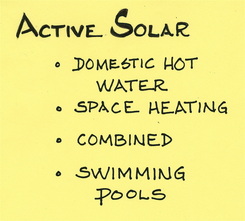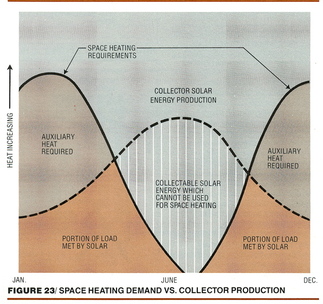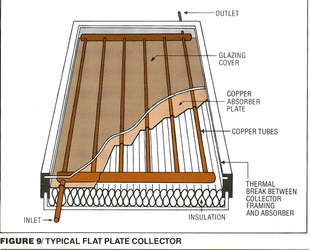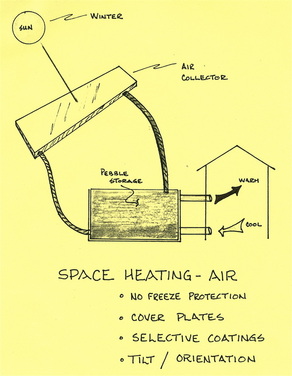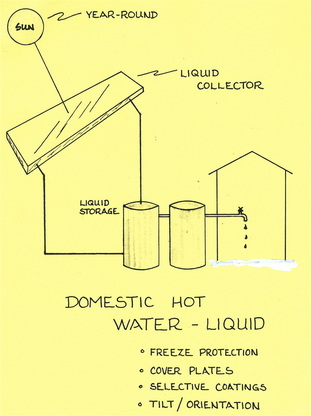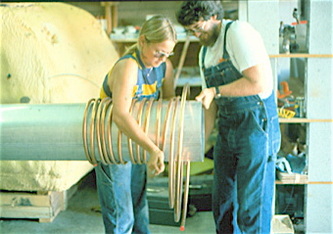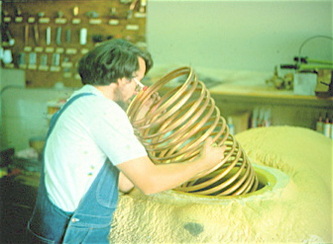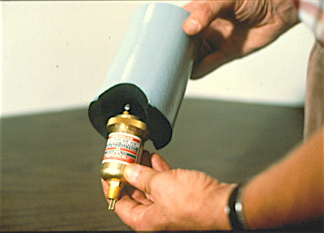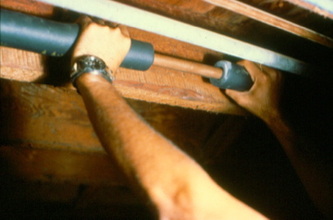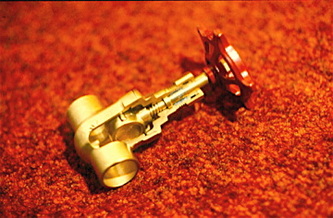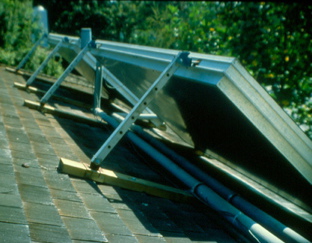Active Solar Thermal Collection for Residences--
Solar potential--
|
|
Active Solar Collection
This technology harvests the thermal properties of converted solar radiation as a result of its arrival as short wave energy (think microwave) and becoming long wave energy (think toaster oven). This capture has nothing to do with making electricity. This radiation conversion would be the same if it simply struck the ground and became heat. The difference is that it's being intercepted, concentrated, stored, and used. Active solar capture involves multiple pieces of infrastructure which make the conversion to heat and transportation and storage of that heat possible. This involves panels, pipes, pumps, thermostats, and various forms of freeze protection for the collection loop. Such systems make it possible to separate and orient the collecting panels from a building that might not be oriented or pitched properly to capture solar radiation. |
A liquid-based, active solar space heating system
|
There are a variety of collection types, working fluids, and distribution methods. They permit buildings and HVAC (heating, ventilation, and air conditioning) systems to be much more "conventional" than passive solar collection would. The most cost effective installations provide 55-70% of residential needs (not 100%). Active solar collection can capture thermal energy for three main purposes: space heating, domestic hot water, and pool heating. Living in such a home, one can be fairly oblivious to its systems other than routine inspections and maintenance. You live your life, and your active solar system works in the background.
Liquid, flat plate collectors--
Roof and wall orientation are not as important with active versus passive because the panels can be oriented independently. They collect energy based on their design. Here now are four illustrations, courtesy of the Copper Development Association.
In the first three illustrations, notice the energy gains versus losses through emittance. Panel number three has a selective surface black "electroplated" coating that absorbs more radiant energy and emits less back to the atmosphere. It is more efficient than the others. The last illustration exhibits the standard liquid supply-return scenario. All fluid makes only one pass across the collector surface rather than to serpentine up, down, and across. Fluid running cooler at a panel's exit point likely means that pumping speed is good, and that fluid temps are not so high as to re-radiate heat to the sky through glazing. The place to concentrate heat is inside the insulated storage tank!
|
Schematic of an active air/rock solar system
|
An Air - Rock System
The collector has an air chamber that becomes superheated and triggers fans in the storage loop to open dampers and bring the hot air into storage where it circulates among smooth, rounded rock. The rock must stack in ways that allow pore spaces between them so that air can move through, dumping its BTU load to rocks cooler than the collected air stream.
|
Those pore spaces also have to pull heat from the rocks when the inside space's thermostat calls for heat. So, a series of motorized dampers within insulated air ducting needs to operate in three separate modes; collection to storage, collection direct to interior, or storage to interior.
Such a system would work best when the duct runs are as short as possible, the rock storage is highly insulated, and the back-up heating system is able to seamlessly intervene when storage is depleted or the sun won't shine.
The remaining active solar heating systems featured work with liquids as the heat transfer medium, almost always with a heat exchanger between the potable water supply and the collection loop. Potable water on a roof in either a tank-type batch collector or inside a thermal panel is susceptible to boiling and freezing. The former can be solved to a great extent. The later can only be prevented by an assortment of sensors, pumping (previously warmed) water into panels during sub-freezing weather, or drain-down arrangements triggered by freezing temperatures and a controller device dependent upon electricity.
Such a system would work best when the duct runs are as short as possible, the rock storage is highly insulated, and the back-up heating system is able to seamlessly intervene when storage is depleted or the sun won't shine.
The remaining active solar heating systems featured work with liquids as the heat transfer medium, almost always with a heat exchanger between the potable water supply and the collection loop. Potable water on a roof in either a tank-type batch collector or inside a thermal panel is susceptible to boiling and freezing. The former can be solved to a great extent. The later can only be prevented by an assortment of sensors, pumping (previously warmed) water into panels during sub-freezing weather, or drain-down arrangements triggered by freezing temperatures and a controller device dependent upon electricity.
|
A liquid -to- fan coil
space heating system This one uses a closed loop of antifreeze treated fluid to circulate in the panels to a heat exchanger located in a large volume storage tank. Rules of thumb match 1.5 gallons of storage to each square foot of collector. Go lower and you get higher temps and lower efficiency. Use greater storage and you get lower temps and greater efficiency. To make the liquid -to- air exchanger (essentially a fan-backed radiator like your car) deliver heat at a temperature resembling your furnace, the liquid temperature must be very high (130°F). If this is a heating only system (as shown) and not combined with hot water, you'll want the collector tilt at a higher angle to better meet and optimize with winter sun angles. That would be latitude plus 15-20°. |
An active, liquid exchanging solar heating system
|
|
A liquid-to-liquid Domestic Hot Water system (DHW) This system uses liquid in the panel driving a double-walled heat exchanger in the pre-heat tank. The second tank is a standard water heater with the ability to "finish" the pre-heat or perform completely on its own. The two-tank system is more expensive (but more efficient) than a single tank. It allows circulating fluid to approach the panel at a lower temperature than if it had come from our only tank (boosted to a 120° setting for our comfort). Panels give up more BTUs per fluid pass if that fluid is cooler. Therefore, more BTUs can be harvested, and more money saved. |
When the panel thermostat registers a temperature high enough above the water in the pre-heat tank, pumping will begin. It will cease as those temperatures near each other.
A domestic hot water system in new or retrofit applications will provide the quickest payback over space heating systems because the load it supplants is daily and year round. Although you might not get as much radiation in the winter, if you are consistent in your hot water use you'll take everything the sun can give. And that's the most efficient use of your solar investment. To have such a system and do all your laundry on Saturdays will lengthen your payback considerably.
A domestic hot water system in new or retrofit applications will provide the quickest payback over space heating systems because the load it supplants is daily and year round. Although you might not get as much radiation in the winter, if you are consistent in your hot water use you'll take everything the sun can give. And that's the most efficient use of your solar investment. To have such a system and do all your laundry on Saturdays will lengthen your payback considerably.
|
A Liquid-to-Liquid (Combined)
HVAC + DHW System-- The engineering behind this system is the most complicated yet. Once the DHW and space heating load are known, the decision must be made as to how much of a fraction of their needs will be attempted by solar. This means how much panel square footage will be needed? How large a storage tank? What kind and size of in-tank heat exchanger will be used for the DHW pre-heat? The good news is that the target temperatures for the HVAC liquid-to-air exchanger and that of the water heater are very close. The bad news is that the more collection and storage you add here, the more wasted summer heat that the DHW probably cannot recover and therefore the lower the entire system's efficiency (cost vs performance). But, as prices for energy climb, this concern will lessen. Any significant offset of fossil-based fuels will be welcomed. |
The solar swimming pool heating system is a very efficient one, particularly in all-year, outdoor swimming climates that (let's face it, are few). But, while in operation, the target temperature of the pool and the after-panel water temperature are very close. The pool target is perhaps 80°F. The ambient temperature on a roof on a sunny day is at least close to that in cool weather and well above it in summer. So, we get to operate without a boxed panel underneath glazing.
In fact, the high roof temps of summer contribute to the heat taken in by the passing pool water in the "matt" of pipes representing the collector. Any area in an attic or ceiling that has pool collectors covering it will stay at a cooler temperature; something to think about in air conditioning season.
The fluid dynamics are different than all other liquid collection systems. We're pushing a large volume of water across such panels at a moderate rate of flow. You've got a whole pool full of cooler water that can approach the roof and make the most of the BTU harvest on every pass. When the sun sets and/or the roof cools off, sensors tell the pump to quit and all the water drains back into the pool. This represents an automatic defense against freeze damage in any season. Kill the power by outage or by solar controller and all the water drains out and into a large reservoir that cannot freeze (an hopefully is fitted with a pool cover to save even more energy).
If not scheduled to be filtering or cleaning during solar gain, most pool pumps can handle the dead lift of water up and through the collectors without being upgraded. There are valves and controls to be changed, but the plumbing is straightforward in this application.
In fact, the high roof temps of summer contribute to the heat taken in by the passing pool water in the "matt" of pipes representing the collector. Any area in an attic or ceiling that has pool collectors covering it will stay at a cooler temperature; something to think about in air conditioning season.
The fluid dynamics are different than all other liquid collection systems. We're pushing a large volume of water across such panels at a moderate rate of flow. You've got a whole pool full of cooler water that can approach the roof and make the most of the BTU harvest on every pass. When the sun sets and/or the roof cools off, sensors tell the pump to quit and all the water drains back into the pool. This represents an automatic defense against freeze damage in any season. Kill the power by outage or by solar controller and all the water drains out and into a large reservoir that cannot freeze (an hopefully is fitted with a pool cover to save even more energy).
If not scheduled to be filtering or cleaning during solar gain, most pool pumps can handle the dead lift of water up and through the collectors without being upgraded. There are valves and controls to be changed, but the plumbing is straightforward in this application.
Active Solar Photo Galleries
(click on image for a larger view and captions)
(click on image for a larger view and captions)
Pipes & Plumbing
Whether it's liquid pipes or air ducting, the active solar system is totally dependent upon these insulated conveyances to harvest and distribute the heat gained by collectors. Using good materials and workmanship is important in the battle over wind, rain, freezing, and summertime outages that stop pumps and stagnate liquid panels with extreme heat. In the years since these dated photos were taken, an army of professional installers armed with simple and more elegant components has taken lots of the complexity out of active solar.
Panel Mounts, Lifts, and Ladders
Punching holes in a perfectly good roof can unnerve any homeowner. Fortunately, there are proven techniques to "get 'er done!" Climbing on and off roofs with construction materials can be hazardous, so please be safe. As in solar plumbing, the maturing industry has developed excellent mounting materials and hardware that will hold panels and pipes in place for the duration without leaks. For experienced installers (up there), it's just like another day at the office.

